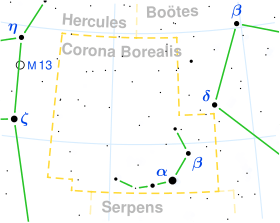Lambda Coronae Borealis
Lambda Coronae Borealis, Latinised from λ Coronae Borealis, is a star located in the constellation Corona Borealis, at a distance of 41.6 parsecs (136 ly). It is also known as HR 5936, and HD 142908.
 | |
| Observation data Epoch J2000 Equinox | |
|---|---|
| Constellation | Corona Borealis |
| Right ascension | 15h 55m 47.58679s[1] |
| Declination | +37° 56′ 49.0491″[1] |
| Apparent magnitude (V) | 5.424[2] |
| Characteristics | |
| Spectral type | F2 IV-V[3] |
| U−B color index | +0.01[4] |
| B−V color index | +0.34[4] |
| Astrometry | |
| Radial velocity (Rv) | -11.60 ± 0.8[5] km/s |
| Proper motion (μ) | RA: 29.099[6] mas/yr Dec.: 79.528[6] mas/yr |
| Parallax (π) | 24.0631 ± 0.0890[6] mas |
| Distance | 135.5 ± 0.5 ly (41.6 ± 0.2 pc) |
| Absolute magnitude (MV) | +2.34[7] |
| Details | |
| Mass | 1.41[8] M☉ |
| Radius | 2.13[6] R☉ |
| Luminosity | 9.382[6] L☉ |
| Surface gravity (log g) | 3.6[9] cgs |
| Temperature | 6,800[9] K |
| Metallicity [Fe/H] | −0.2[9] dex |
| Rotational velocity (v sin i) | 75[9] km/s |
| Age | 1.6[7] Gyr |
| Other designations | |
| Database references | |
| SIMBAD | data |
Lambda Coronae Borealis has been assigned a spectral class of F2 IV-V, meaning it is somewhat hotter than the sun and shows spectral features intermediate between a main sequence and subgiant star. It has an effective temperature of 6,800 K and radius of 2.13 R☉, making for a bolometric luminosity of 9.382 L☉.
Lambda Coronae Borealis has an 11th magnitude companion star 1.5′ away.
References
- van Leeuwen, F.; et al. (2007). "Validation of the new Hipparcos reduction". Astronomy and Astrophysics. 474 (2): 653–664. arXiv:0708.1752. Bibcode:2007A&A...474..653V. doi:10.1051/0004-6361:20078357.
- Høg, E.; et al. (2000). "The Tycho-2 catalogue of the 2.5 million brightest stars". Astronomy and Astrophysics. 355: L27–L30. Bibcode:2000A&A...355L..27H.
- Gray, R. O.; Graham, P. W.; Hoyt, S. R. (2001). "The Physical Basis of Luminosity Classification in the Late A-, F-, and Early G-Type Stars. II. Basic Parameters of Program Stars and the Role of Microturbulence". The Astronomical Journal. 121 (4): 2159. Bibcode:2001AJ....121.2159G. doi:10.1086/319957.
- Mermilliod, J.-C. (1986). "Compilation of Eggen's UBV data, transformed to UBV (unpublished)". Catalogue of Eggen's UBV Data., 0 (1986): 0. Bibcode:1986EgUBV........0M.
- Gontcharov, G. A. (2006). "Pulkovo Compilation of Radial Velocities for 35 495 Hipparcos stars in a common system". Astronomy Letters. 32 (11): 759–771. arXiv:1606.08053. Bibcode:2006AstL...32..759G. doi:10.1134/S1063773706110065.
- Brown, A. G. A.; et al. (Gaia collaboration) (August 2018). "Gaia Data Release 2: Summary of the contents and survey properties". Astronomy & Astrophysics. 616. A1. arXiv:1804.09365. Bibcode:2018A&A...616A...1G. doi:10.1051/0004-6361/201833051. Gaia DR2 record for this source at VizieR.
- Holmberg, J.; Nordström, B.; Andersen, J. (2009). "The Geneva-Copenhagen survey of the solar neighbourhood. III. Improved distances, ages, and kinematics". Astronomy and Astrophysics. 501 (3): 941. arXiv:0811.3982. Bibcode:2009A&A...501..941H. doi:10.1051/0004-6361/200811191.
- David, Trevor J.; Hillenbrand, Lynne A. (2015). "The Ages of Early-type Stars: Strömgren Photometric Methods Calibrated, Validated, Tested, and Applied to Hosts and Prospective Hosts of Directly Imaged Exoplanets". The Astrophysical Journal. 804 (2): 146. arXiv:1501.03154. Bibcode:2015ApJ...804..146D. doi:10.1088/0004-637x/804/2/146.
- Gebran, M.; Farah, W.; Paletou, F.; Monier, R.; Watson, V. (2016). "A new method for the inversion of atmospheric parameters of A/Am stars". Astronomy and Astrophysics. 589: A83. arXiv:1603.01146. Bibcode:2016A&A...589A..83G. doi:10.1051/0004-6361/201528052.
This article is issued from Wikipedia. The text is licensed under Creative Commons - Attribution - Sharealike. Additional terms may apply for the media files.